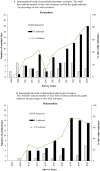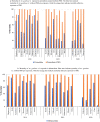Trends of insecticide resistance monitoring in mainland Tanzania, 2004-2020
- PMID: 36932400
- PMCID: PMC10024418
- DOI: 10.1186/s12936-023-04508-3
Trends of insecticide resistance monitoring in mainland Tanzania, 2004-2020
Abstract
Background: Insecticide resistance is a serious threat to the continued effectiveness of insecticide-based malaria vector control measures, such as long-lasting insecticidal nets (LLINs) and indoor residual spraying (IRS). This paper describes trends and dynamics of insecticide resistance and its underlying mechanisms from annual resistance monitoring surveys on Anopheles gambiae sensu lato (s.l.) populations conducted across mainland Tanzania from 2004 to 2020.
Methods: The World Health Organization (WHO) standard protocols were used to assess susceptibility of the wild female An. gambiae s.l. mosquitoes to insecticides, with mosquitoes exposed to diagnostic concentrations of permethrin, deltamethrin, lambdacyhalothrin, bendiocarb, and pirimiphos-methyl. WHO test papers at 5× and 10× the diagnostic concentrations were used to assess the intensity of resistance to pyrethroids; synergist tests using piperonyl butoxide (PBO) were carried out in sites where mosquitoes were found to be resistant to pyrethroids. To estimate insecticide resistance trends from 2004 to 2020, percentage mortalities from each site and time point were aggregated and regression analysis of mortality versus the Julian dates of bioassays was performed.
Results: Percentage of sites with pyrethroid resistance increased from 0% in 2004 to more than 80% in the 2020, suggesting resistance has been spreading geographically. Results indicate a strong negative association (p = 0.0001) between pyrethroids susceptibility status and survey year. The regression model shows that by 2020 over 40% of An. gambiae mosquitoes survived exposure to pyrethroids at their respective diagnostic doses. A decreasing trend of An. gambiae susceptibility to bendiocarb was observed over time, but this was not statistically significant (p = 0.8413). Anopheles gambiae exhibited high level of susceptibility to the pirimiphos-methyl in sampled sites.
Conclusions: Anopheles gambiae Tanzania's major malaria vector, is now resistant to pyrethroids across the country with resistance increasing in prevalence and intensity and has been spreading geographically. This calls for urgent action for efficient malaria vector control tools to sustain the gains obtained in malaria control. Strengthening insecticide resistance monitoring is important for its management through evidence generation for effective malaria vector control decision.
Keywords: Insecticide resistance; Malaria vectors; Resistance trends; Tanzania.
© 2023. The Author(s).
Conflict of interest statement
The authors declare that they have no competing interests.
Figures









References
-
- WHO. World malaria report 2020. Geneva: World Health Organization; 2020. http://www.who.int/malaria/publications/world-malaria-report-2020/wmr202.... Accessed Nov 2021.
-
- Universal Coverage Campaign. Final impact. http://medatanzania.org/?p=ucc_final.
MeSH terms
Substances
LinkOut - more resources
Full Text Sources
Medical

